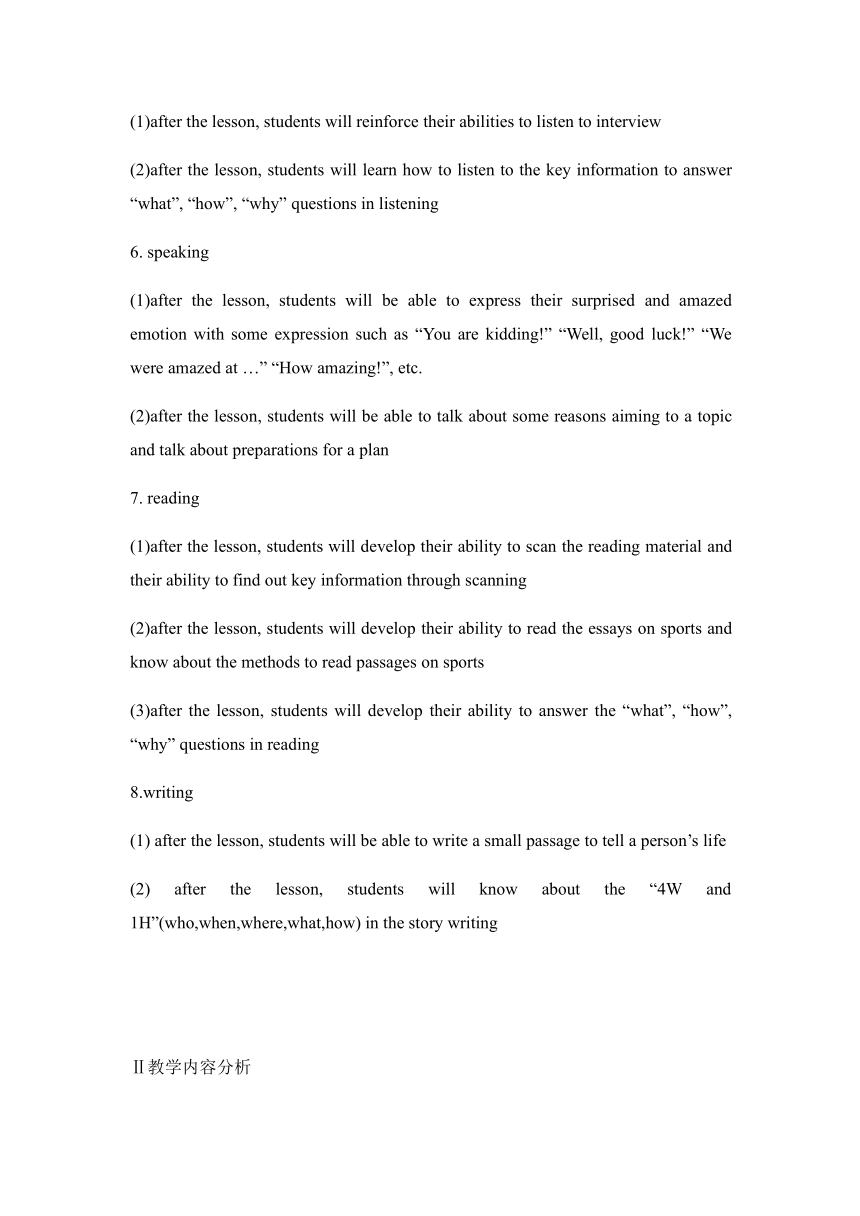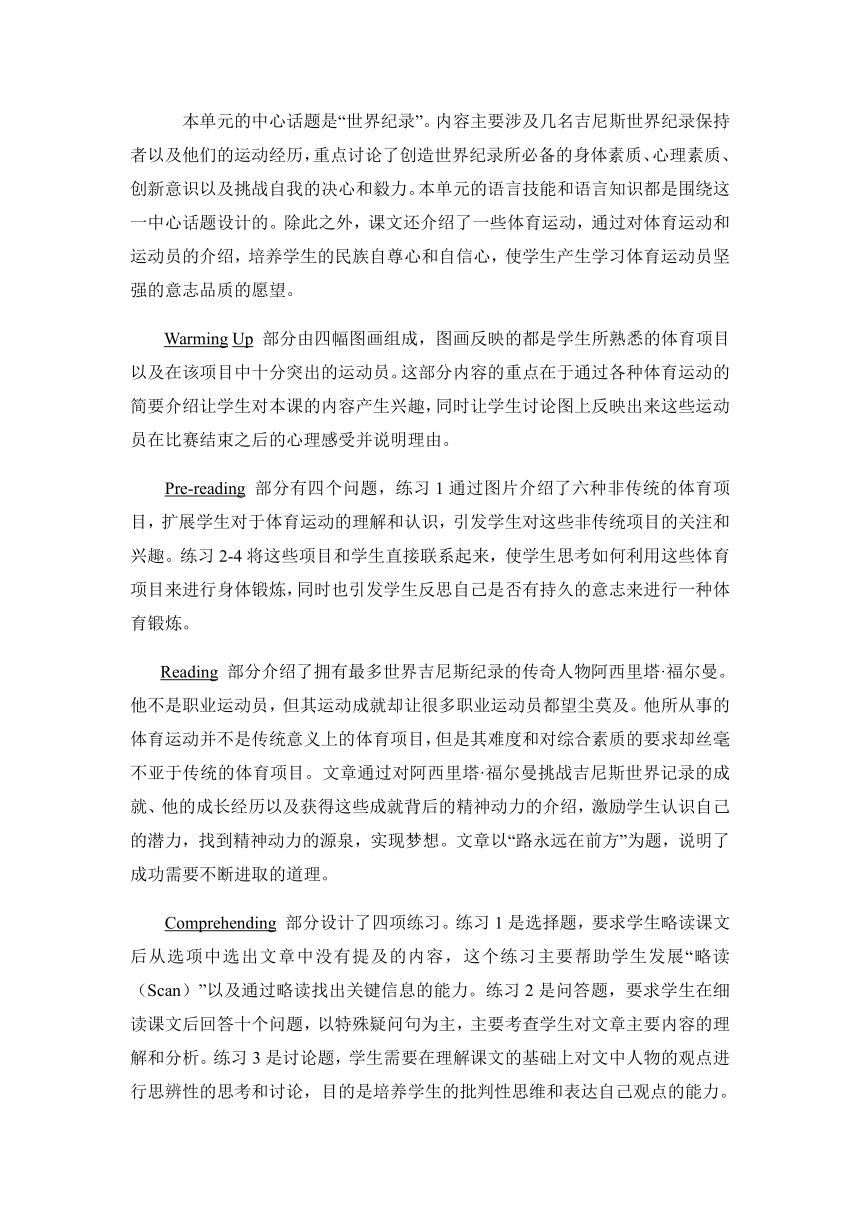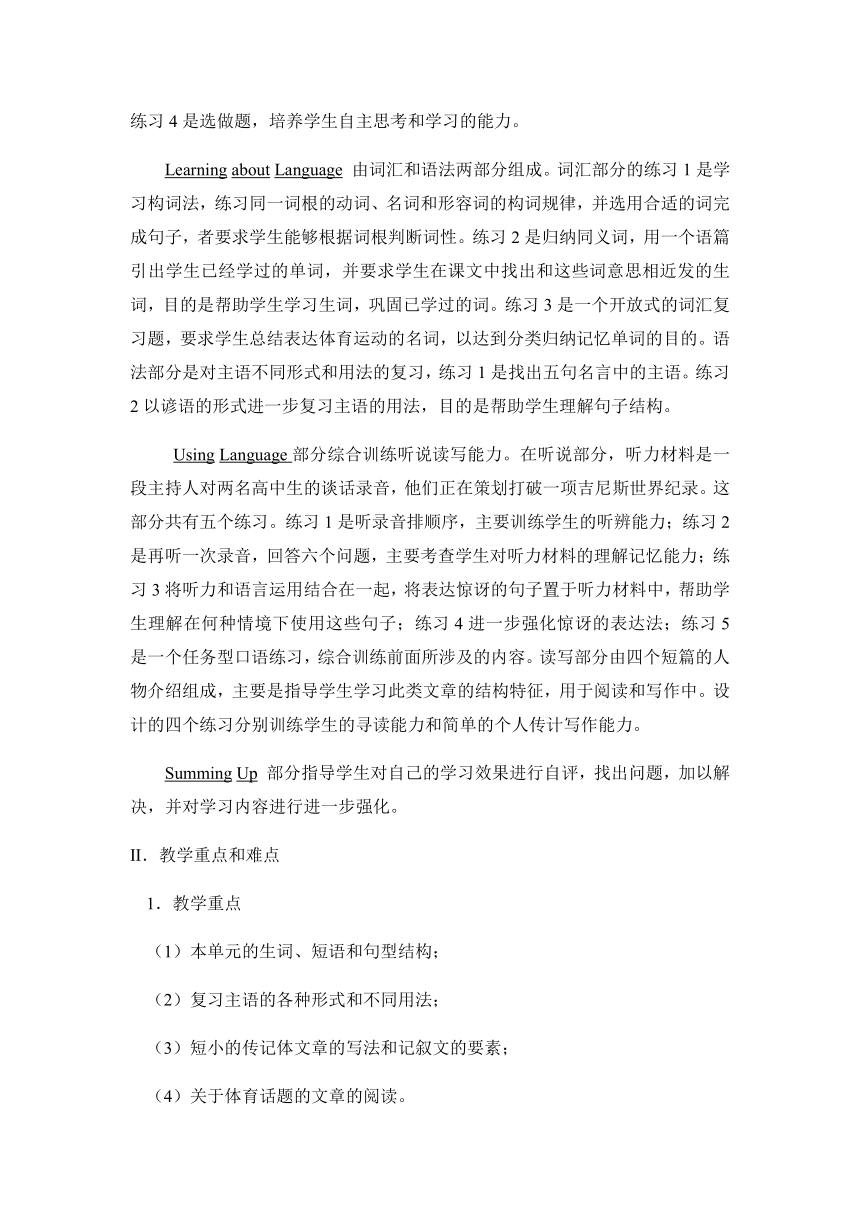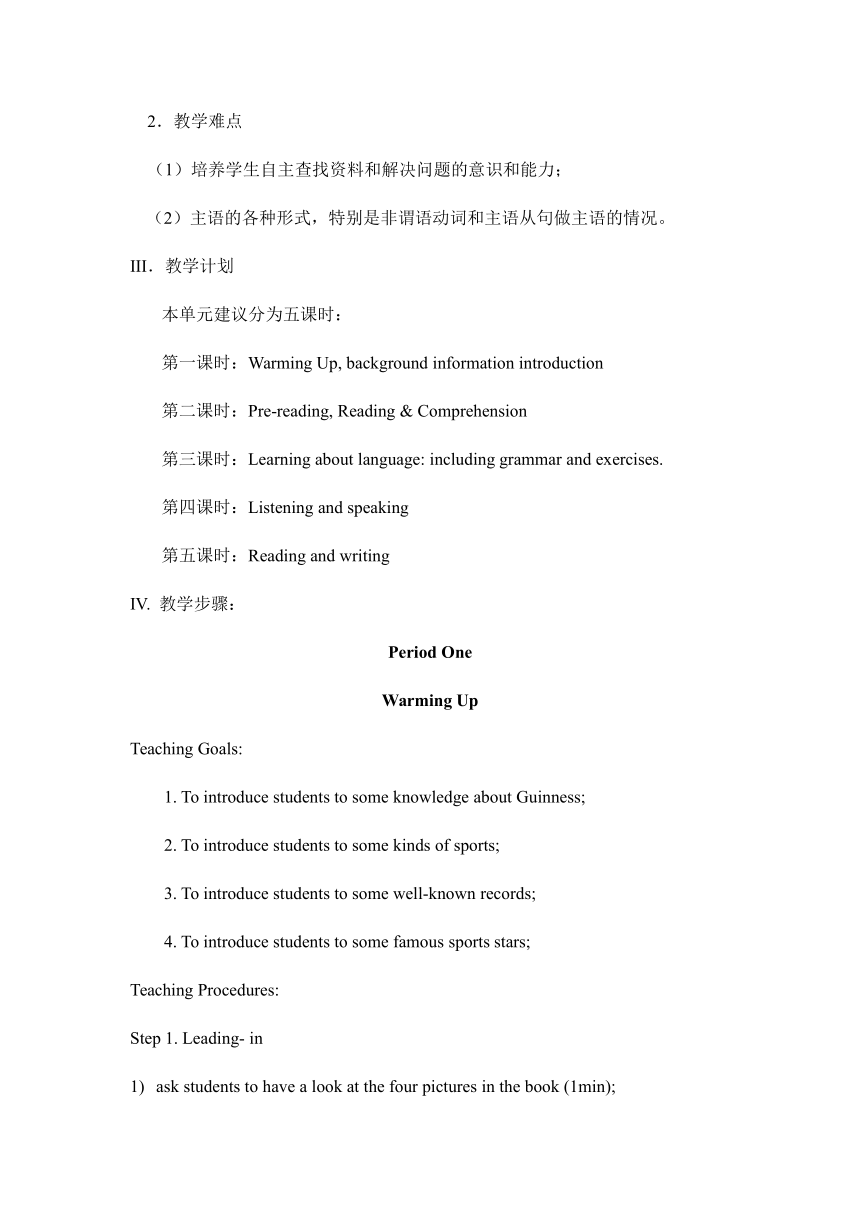人教新课标英语选修九Unit 1 Breaking records (单元教案)
文档属性
| 名称 | 人教新课标英语选修九Unit 1 Breaking records (单元教案) |

|
|
| 格式 | zip | ||
| 文件大小 | 6.1MB | ||
| 资源类型 | 教案 | ||
| 版本资源 | 人教版(新课程标准) | ||
| 科目 | 英语 | ||
| 更新时间 | 2019-12-06 11:20:06 | ||
图片预览





文档简介
Unit 1 Breaking records
Ⅰ教学目标(Teaching objectives)
1. vocabulary
(1)after the lesson, students will know about some new words about sports and use these words to express their opinion on sports
(2)after the lesson, students will know about the words expressing their emotions such as surprising, exciting, depressing and so on
2. grammar
After the lesson, students will develop their understanding of the form and uses of subject
3. knowledge
(1)after the lesson, students will know about some basic information about the world's records
(2)after the lesson, students will know about the basic information about Chinese famous record breakers and their ways to achieve their goals
(3)after the lessonn, students will know about more sports and know more about their familiar sports
4. emotion
(1)after the lesson, students will feel proud of Chinese athletes and develop their patriotism
(2)after the lesson, students will learn from those successful record breakers’ hardwirking and stick-at-itiveness
5. listening
(1)after the lesson, students will reinforce their abilities to listen to interview
(2)after the lesson, students will learn how to listen to the key information to answer “what”, “how”, “why” questions in listening
6. speaking
(1)after the lesson, students will be able to express their surprised and amazed emotion with some expression such as “You are kidding!” “Well, good luck!” “We were amazed at …” “How amazing!”, etc.
(2)after the lesson, students will be able to talk about some reasons aiming to a topic and talk about preparations for a plan
7. reading
(1)after the lesson, students will develop their ability to scan the reading material and their ability to find out key information through scanning
(2)after the lesson, students will develop their ability to read the essays on sports and know about the methods to read passages on sports
(3)after the lesson, students will develop their ability to answer the “what”, “how”, “why” questions in reading
8.writing
(1) after the lesson, students will be able to write a small passage to tell a person’s life
(2) after the lesson, students will know about the “4W and 1H”(who,when,where,what,how) in the story writing
Ⅱ教学内容分析
本单元的中心话题是“世界纪录”。内容主要涉及几名吉尼斯世界纪录保持者以及他们的运动经历,重点讨论了创造世界纪录所必备的身体素质、心理素质、创新意识以及挑战自我的决心和毅力。本单元的语言技能和语言知识都是围绕这一中心话题设计的。除此之外,课文还介绍了一些体育运动,通过对体育运动和运动员的介绍,培养学生的民族自尊心和自信心,使学生产生学习体育运动员坚强的意志品质的愿望。
Warming Up 部分由四幅图画组成,图画反映的都是学生所熟悉的体育项目以及在该项目中十分突出的运动员。这部分内容的重点在于通过各种体育运动的简要介绍让学生对本课的内容产生兴趣,同时让学生讨论图上反映出来这些运动员在比赛结束之后的心理感受并说明理由。
Pre-reading 部分有四个问题,练习1通过图片介绍了六种非传统的体育项目,扩展学生对于体育运动的理解和认识,引发学生对这些非传统项目的关注和兴趣。练习2-4将这些项目和学生直接联系起来,使学生思考如何利用这些体育项目来进行身体锻炼,同时也引发学生反思自己是否有持久的意志来进行一种体育锻炼。
Reading 部分介绍了拥有最多世界吉尼斯纪录的传奇人物阿西里塔·福尔曼。他不是职业运动员,但其运动成就却让很多职业运动员都望尘莫及。他所从事的体育运动并不是传统意义上的体育项目,但是其难度和对综合素质的要求却丝毫不亚于传统的体育项目。文章通过对阿西里塔·福尔曼挑战吉尼斯世界记录的成就、他的成长经历以及获得这些成就背后的精神动力的介绍,激励学生认识自己的潜力,找到精神动力的源泉,实现梦想。文章以“路永远在前方”为题,说明了成功需要不断进取的道理。
Comprehending 部分设计了四项练习。练习1是选择题,要求学生略读课文后从选项中选出文章中没有提及的内容,这个练习主要帮助学生发展“略读(Scan)”以及通过略读找出关键信息的能力。练习2是问答题,要求学生在细读课文后回答十个问题,以特殊疑问句为主,主要考查学生对文章主要内容的理解和分析。练习3是讨论题,学生需要在理解课文的基础上对文中人物的观点进行思辨性的思考和讨论,目的是培养学生的批判性思维和表达自己观点的能力。练习4是选做题,培养学生自主思考和学习的能力。
Learning about Language 由词汇和语法两部分组成。词汇部分的练习1是学习构词法,练习同一词根的动词、名词和形容词的构词规律,并选用合适的词完成句子,者要求学生能够根据词根判断词性。练习2是归纳同义词,用一个语篇引出学生已经学过的单词,并要求学生在课文中找出和这些词意思相近发的生词,目的是帮助学生学习生词,巩固已学过的词。练习3是一个开放式的词汇复习题,要求学生总结表达体育运动的名词,以达到分类归纳记忆单词的目的。语法部分是对主语不同形式和用法的复习,练习1是找出五句名言中的主语。练习2以谚语的形式进一步复习主语的用法,目的是帮助学生理解句子结构。
Using Language部分综合训练听说读写能力。在听说部分,听力材料是一段主持人对两名高中生的谈话录音,他们正在策划打破一项吉尼斯世界纪录。这部分共有五个练习。练习1是听录音排顺序,主要训练学生的听辨能力;练习2是再听一次录音,回答六个问题,主要考查学生对听力材料的理解记忆能力;练习3将听力和语言运用结合在一起,将表达惊讶的句子置于听力材料中,帮助学生理解在何种情境下使用这些句子;练习4进一步强化惊讶的表达法;练习5是一个任务型口语练习,综合训练前面所涉及的内容。读写部分由四个短篇的人物介绍组成,主要是指导学生学习此类文章的结构特征,用于阅读和写作中。设计的四个练习分别训练学生的寻读能力和简单的个人传计写作能力。
Summing Up 部分指导学生对自己的学习效果进行自评,找出问题,加以解决,并对学习内容进行进一步强化。
II.教学重点和难点
1. 教学重点
(1)本单元的生词、短语和句型结构;
(2)复习主语的各种形式和不同用法;
(3)短小的传记体文章的写法和记叙文的要素;
(4)关于体育话题的文章的阅读。
2.教学难点
(1)培养学生自主查找资料和解决问题的意识和能力;
(2)主语的各种形式,特别是非谓语动词和主语从句做主语的情况。
III.教学计划
本单元建议分为五课时:
第一课时:Warming Up, background information introduction
第二课时:Pre-reading, Reading & Comprehension
第三课时:Learning about language: including grammar and exercises.
第四课时:Listening and speaking
第五课时:Reading and writing
IV. 教学步骤:
Period One
Warming Up
Teaching Goals:
1. To introduce students to some knowledge about Guinness;
2. To introduce students to some kinds of sports;
3. To introduce students to some well-known records;
4. To introduce students to some famous sports stars;
Teaching Procedures:
Step 1. Leading- in
1) ask students to have a look at the four pictures in the book (1min);
2) ask students whether they can name the sports and the sport stars;
3) ask students to assume themselves as the athletes in the picture and talk about how they feel when they win the games.
Step 2. Introduction to Guinness
1) ask students what they know about Guinness and how many Guinness records they know;
For example:
1 What do you know about Guinness?
2 How many Guinness records do you know?
3 Do you know the Guinness record that…?
2) orgnize a guessing game: True or False. List a few statements about Guinness records and ask students to guess they are true or false. For example: The world record of the 110 metres hurdle race is 12.91 seconds. (False);
3) give a brief introduction on the history of Guinness and some interesting stories in the history of Guinness;
Step 3. Introduction to well-known records
1) do a little survey in the class to find out how many world records the students know and what they are; the form of the survey could be questionnaire or oral question; this activity can be organized to be a group work. Students can be divided into a few groups and each group try their best to brainstorm out the records they know. In the end, one representative from each group come to the blackboard to write their results. The group who write the most records will be the winner.
2) Teacher picks out some outstanding records form what students write on the blackboard to give a detailed introduction;
3) Discuss why these well-known records can be achieved; it can be considered from the aspects of the records breakers, science technology developing, etc.; this part is to invoke students’ thinking, so the focus should be on students’ thoughts but not the correctness of language.
Step 4. Introduction to some famous sports stars
1) Teacher asks question “who is your favorite sports star?” for the students to think of. Then do a little survey to find out who is the most popular sport star in class;
2) Teacher introduces his/her favorite sport star and explain the reasons why he/she likes the sport star, aiming to set an example for students to follow in the next step;
3) Guide students to think about why they like those sports stars. (From virious aspects; aim to inspire students think independently);
4) If allows, teacher can play some videos about the development of famous athletes;
Period 2
Pre-reading, Reading & Comprehension
Teaching Goals:
1. strengthen students’ ability to read and understand essays on sports
2. get students familiar with some vocabulary of sports
3. develop students’ ability to scan and answer “why”, “what”, “how” questions
Teaching Procedures:
Step 1. Review
1) show some pictures of the traditional sports for students and ask “what are these sports?”. It can be used to help students to review the vocabulary;
2) ask students to recall the names of some famous records breaker;
Step 2. Pre-reading
1) ask students to look at the six pictures on the book and guess what sports they are;
2) ask students to do exercise one, and make them familiar with these new words;
3) ask students “can you do some of these sports?” in order to find out how many of these sports are familiar to students;
4) give a brief introduction of these sports, mainly on how to do these sports;
5) ask some of the students to model the people in these pictures to do these sports in class and ler other students to guess what the sports are;
6) brainstorming: give a topic for the students to discuss; the topic can be “what are the main differences between the sports in Olympic Games and the sports in the pictures?” or “which of these sports in the pictures is your favorite? Why?”, etc.
7) lead-in: teacher asks “Do you believe that one person can keep all the Guiness records of these six sports?” to lead students to the reading part.
Step 3. Reading and Comprehending
1) ask students to look through the text and find out the main idea;it can be done in the form of pair work or group work and teacher can ask one student of each group to give his/her group’s opinion on the main idea of the text; at last, teacher mixes up their answers and summarize the main idea;
2) give a brief introduction about the text and some extra information relating to Ashrita Furman;
3) ask students to find out how many records that Ashrita Furman kept are mentioned in the text and do exercise 1; (if the sport is covered in the text, find out which paragraph it is in; if not, put a cross next to it)
4) guide students to summarize the general meaning of each paragraph;
a group work can be organized here, all the students can be divided into 13 groups and each group summarize one paragraph;
5) ask students to read the text again and do exercise 2; in this period, students can exchange their ideas freely; then, teacher affords some referenced answers to these questions;
6) teach the language points in the text, including vocabulary, phrases and sentences, etc.
7) ask students “How do you think of the title of this text?”; in this period, inspire students to give some creative answers; the aim of this questions is to develop students’ ability to think of the deeper meaning of some sentence and also develop their understanding of English language;
8) group work: Ashrita Furman In Your Mind
Ask students to read the text again and draw the picture of Ashrita Furman according to the description in the text;
9) brainstorming: exercise 3;
students can be divided into two parts, one is to support the statement and the other is to be against the statement and two sides argue with each other; the more reasons the group can raise, the group will win;
10) homework: exercise 4.
Period 3
Learning about language: including grammar and exercises
Teaching Goals:
1. make students familiar with the usual suffixes of verb, noun and adjective;
2. develop students’ ability to refer to noun from verb or adjective, to refer to adjective from verb or noun;
3. to strengthen students’ understanding of different forms of subjective and the usage of subjective.
Teaching Procedures:
Step 1. Review
Common suffixes of noun:
(1) 具有某种职业或动作的人
1)-an, -ain, 表示"……地方的人,精通……的人”American, historian,
2)-al, 表示"具有……职务的人" principal,
3)-ant,-ent, 表示"……者” merchant, agent, servant, student,
4)-ar, 表示"……的人” scholar, liar, peddler
5)-ard, -art, 表示"做……的人”coward, laggard, braggart(夸张者)
6)-arian, 表示"……派别的人, ……主义的人”humanitarian, vegetarian
7)-ary, 表示"从事……的人" secretary, missionary
8)-ant, 表示"具有……职责的人" candidate, graduate
9)-ator, 表示"做……的人" educator, speculator(投机者)
10)-crat, 表示"某种政体,主义的支持者" democrat, bureaucrat
11)-ee, 表示"动作承受者" employee, examinee
12)-eer, 表示"从事于……人" engineer, volunteer
13)-er, 表示"从事某种职业的人, 某地区,地方的人" banker, observer, Londoner, villager
14)-ese, 表示" ……国人,…..地方的人”Japanese, Cantonese
15)-ess, 表示"阴性人称名词, actress, hostess, manageress
16)-eur, 表示"……家” amateur, littérateur
17)-ian, 表示"……地方人,信仰…….教的人,从事……职业的人”Christian, physician(内科医生),musician
18)-ician, 表示"精通者, ……家,”electrician, magician, technician
19)-icist, 表示"……家, …….者, …….能手”physicist, phoneticist, technicist
20)-ic, 表示"……者,……师" mechanic, critic
21)-ie, 表示"爱,指小" dearie, auntie, lassie(小姑娘)
22)-ier, 表示"从事……职业” cavalier, clothier, brazier(黄铜匠)
23)-ine, ian, 表示"阴性人称" heroine, ballerina
24)-ist, 表示"从事……研究者,信仰……主义者" pianist, communist, dentist, artist, chemist
25)-ive, 表示"动作者,行为者” native, captive
26)-logist, 表示"……学家,研究者" biologist, geologist(地质学家)
27)-or, 表示"……者" author, doctor, operator,
28)-ster, 表示"做…….事情的人”youngster, gamester(赌徒),songster
29)-yer, 表示" 从事……职业者” lawyer
(2). 构成,具有抽象名词的含义
1)-acy, 表示"性质,状态,境遇" accuracy, diplomacy
2)-age, 表示"状态,行为,身份及其结果,总称" courage, storage, marriage
3)-al, a) 表示"事物的动作,过程”refusal, arrival, survival, denial, approval
b) 表示具体的事物manual, signal, editorial, journal
4)-ance, -ence表示"性质,状况,行为,过程,总量,程度” endurance, importance, diligence, difference, obedience
5)-ancy, -ency, 表示"性质,状态,行为,过程" frequency, urgency, efficiency,
6)-bility, 表示"动作,性质,状态" possibility, feasibility,
7)-craft, 表示"工艺,技巧” woodcraft, handicraft, statecraft(治国策)
8)-cracy, 表示"统治,支配" bureaucracy, democracy
9)-cy, 表示"性质,状态,职位,级别" bankruptcy(破产),supremacy
10)-dom, 表示"等级,领域,状态" freedom, kingdom, wisdom
11)-ery, -ry, 表示"行为,状态,习性" bravery, bribery, rivalry
12)-ety, 表示"性质,状态” variety, dubiety(怀疑)
13)-faction, -facture, 表示"作成,……化,作用" satisfaction, manufacture
14)-hood, 表示"资格,身份, 年纪,状态" childhood, manhood, falsehood
15)-ice, 表示"行为,性质,状态" notice, justice, service
16)-ine, 表示"带有抽象概念" medicine, discipline, famine
17)-ing, 表示"动作的过程,结果" building, writing, learning
18)-ion, -sion, -tion, -ation, -ition, 表示"行为的过程,结果,状况" action, solution, conclusion, destruction, expression, correction
19)-ise, 表示"性质,状态” exercise, merchandise(商业)
20)-ism, 表示"制度,主义,学说,信仰,行为" socialism, criticism, colloquialism, heroism
21)-ity, 表示"性质,状态,程度” purity, reality, ability, calamity
22)-ment, 表示"行为,状态,过程,手段及其结果 treatment, movement, judgment, punishment, argument
23)-mony, 表示"动作的结果,状态" ceremony, testimony
24)-ness, 表示"性质,状态,程度" goodness, kindness, tiredness, friendliness
25)-or, -our, 表示"动作,性质,状态" favor, error,
26)-osity, 表示"动作,状态” curiosity
27)-ship, 表示"情况,性质,技巧,技能及身份,职业” hardship, membership, friendship
28)-th, 表示"动作,性质,过程,状态" depth, wealth, truth, length, growth
29)-tude, 表示"性质,状态,程度" latitude, altitude(海拔)
30)-ure, 表示"行为,结果" exposure, pressure, failure, procedure(手续),
31)-y, 表示"行为的结果,状态,性质” glory, history, victory, inquiry
(3) 带有场所,地方的含义
1)-age, 表示"住所,地点" village, cottage
2)-ary, 表示"住所,场地" library, granary (谷仓)
3)-ery, ry, 表示"工作场所,饲养所,地点" laundry, nursery, surgery(手术室)
4)-ory, 表示"工作场所,住处" factory, dormitory, laboratory, observatory
(4) 带有学术,科技含义
1)-grapy, 表示"……学,写法” biography, calligraphy, geography
2)-ic, ics, 表示"……学……法" logic, mechanics, optics, electronics
3)-ology, 表示"……学……论”biology, zoology, technology(工艺学)
4)-nomy, 表示"……学……术" astronomy, economy, bionomy(生态学)
5)-ery, 表示"学科,技术" chemistry, cookery, machinery
6)-y, 表示"……学,术,法” photography, philosophy
(5) 表示人和事物的总和,集合含义
1)-age, baggage, tonnage
2)-dom, newspaperdom(新闻界)
3)-hood, neighbourhood, womanhood
4)-ery, cavalry, ministry(内阁)
5)-ure, legislature, judicature
(6) 表示物品和物质名称的含义
1)-ant, ent, solvent, constant
2)-al, signal, pictorial(画报)
3)ar, collar, pillar(石柱)
4)- er, boiler, computer, washer, cooker
5)-ery, drapery(绸缎)
6)-ing, clothing, matting,
7)-ment, instrument, equipment, attachment
(7) 表示“细小”的含义
1)-cle, particle,
2)-cule, molecule(分子)
3)-el, parcel
4)-en, chicken, maiden
5)-et, pocket, ticket
6)-etta, -ette, etto, cigarette, essayette(短文)
7)-kin, napkin
8)-ling, duckling,
9)-let, booklet
10)-y, baby, doggy
Common suffixes of adjecive:
(1)带有“属性,倾向,相关”的含义
1)-able, -ible, movable, comfortable, applicable, visible, responsible
2)-al, natural, additional, educational
3)-an, ane, urban, suburban, republican
4)-ant, -ent, distant, important, excellent
5)-ar, similar, popular, regular
6)-ary, military, voluntary
7)-ice, -atie, ical, politic, systematic, historic, physical,
8)-ine, masculine, feminine, marine
9)-ing, moving, touching, daring
10)-ish, foolish, bookish, selfish
11)-ive, active, impressive, decisive
12)-ory, satisfactory, compulsory
13)-il, -ile, -eel, fragile, genteel(文雅的)
(2) 表示“相象,类似”的含义
1)-ish, boyish, childish
2)-esque, picturesque
3)-like, manlike, childlike
4)-ly, manly, fatherly, scholarly, motherly
5)-some, troublesome, handsome
6)-y, milky, pasty
(3) 表示“充分的”含义
1)-ful, beautiful, wonderful, helpful, truthful
2)-ous, dangerous, generous, courageous, various
3)-ent, violent,
(4) 表示由某种物质形成,制成或生产的含义
1)-en, wooden, golden, woolen
2)-ous, gaseous
3)-fic, scientific
(5) 表示方向的含义
1)-ern, eastern, western
2)-ward, downward, forward
(6) 表示“倍数”的含义
1)-ble, double, treble
2)ple, triple
3)-fold, twofold, tenfold
(7) 表示“数量关系”的含义
1)-teen, thirteen
2)-ty, fifty
3)-th, fourth, fiftieth
(8) 表示国籍,语种,宗教的含义
1)-an, Roman, European
2)-ese, Chinese,
3)-ish, English, Spanish
(9) 表示“比较程度”的含义
1)-er, greater
2)-ish, reddish, yellowish
3)-est, highest
4)-most, foremost, topmost
(10)其他的含义
-less, 表示否定,countless, stainless, wireless
Step2. Exercise 1
1)Ask students to fill in the table and check answers with them;
Verb Noun Adjective
approximate approximation approximate
adjust adjustment adjustable
accomplish accomplishment accomplishable
devote devotion/devotement devotive
motivate motivation motivational
2)Ask students to find out the suffixes of the nouns and adjective in the table;
3)Ask some students to tell the Chinese meaning of the words they fill; teacher check and correct them, especially the differences between “motivation” and “motivator”, “devotion” and “devotement”; the aim is to distinguish different meanings of nouns with different noun-suffixes;
4)Choose proper words in the table to fill in the lines and complete the sentences;
Be动词后面:①adjective ②noun ③v-ing
冠词the/a/an后面:noun/adj +noun
Adjective后面:noun
To:①当to为介词时,后面接noun/v-ing②当to为不定式时,后面接verb原型
Verb后面:noun/adjective+noun
Step3. Exercise 2
1)Teacher hands out tables as follow to students and ask them to fill in the blanks;
usual severe sacred spirit hard begged truth
词性
意义
同义词
2)Ask students “Can anyone of you can write more words whose meaning are similar to the words in the table; this can be done in the form of group work; students give their answers in group;
3)Group work: divide the students into seven groups and ask each group to make a sentence with one word in the table above;
Step4. Exercise 3
1) show students some QQ expressions to students and ask them to use an adjective to describe each expression;
2) ask students “If you …, how will you feel?”; let the students use as many adjectives as possible to express their feelings;
3) ask students “How do you think of football match?” or “Do you think football match is fascinating?”; after students answer, teacher asks “Except fascinating, are there some other feelings a football match can bring to you?”;
4) set an example that “The event of …is …, but the training is ….” for students to follow and practice those words they mentioned before;
Step5. Subjective
1) Review of the basic knowledge of subjective
①非谓语动词作主语
非谓语动词 意义和用法 例句
不定式 动词不定式表示比较具体的意义,经常和特定的动作和执行者联系起来,经常带时间或地点状语,有时表示将要发生的动作。 To master a foreign language is no easy job.To do it well is my earnest desireTo see this film is to waste time.To solve this problem is out of the question
动词不定式(短语)作主语时,常见的另一种形式是在句首用先行代词it作形式主语,而将动词不定式(短语)移到谓语之后作真正主语。用于这种形式是一些特定形容词,动词和名词 1)形容词作表语(常见的形容词有:important, difficult, easy hard possible)It is foolish to act in this way.It sounds reasonable to do it this way.It appears likely for them to arrive.2) 动词作谓语(常见的动词有:require, cost, amuse, delight, irritate, annoyIt took much time to do this.It makes us excited to think about that.It needed hard work to finish the job.It does no good to say like that.It didn't occur to me to ask him to help me.3)名词作表语It seems a pity to waste them.It is a great pleasure to do thisIt is a good idea to think this way.
动名词 ?动名词表示比较抽象(一般)和经常性的意义,有时可同不定式互换 Collecting stamps is a good hobby.Swimming is a best sport in summer.There is no telling what will happen.There is no denying the fact.There is no need informing him of it.?
动名词短语作主语时,常见的另一种形式是在句首用先行代词it作形式主语面将动名词短语移至谓语之后作真实主语。用于这种形式是一些特定形容词和名词 1)形容词作表语(常见的形容词有:enjoyable, good, hard, worthwhile)It is nice talking to you.It's foolish behaving like that.It is useless doing that2)名词作表语It's waste of time doing this. It's no good (use) doing that.It's an awful job doing this. It's fun doing thisIt is not an easy task doing this work.
②主语从句做主语
在句中充当主语的从句叫做主语从句。
他星期三来这里是肯定的。
That he will come here on Wednesday is certain.
注意:从句作主语时,就算是句子意思完整,都要加上从属连词that
他星期三是否来这里还不肯定的。
Whether he will come here on Wednesday is not certain.
注意:主语从句表示“是否” 只用“whether” 而不用“if”
主语从句有时用“it”作形式主语,把真正的主语放在后面,以避免头重脚轻。
It is known to us that he will come here.
用it形式主语的that从句有以下四种不同的搭配
1 It + be + 形容词 + that从句
It is necessary that… 有必要…
It is important that …. 重要的是…
It is obvious that…… 很明显……
2
2 It + be + -ed分词 + that从句
It is believed that… 人们相信…
It is known to us/all that …. 众所周知…
It has been decided that…… 已经决定……
3 It + be + 名词 + that从句
It is common knowledge that… …是常识
It is a surprise that …. 令人惊奇的是…
It is a fact that…… 事实是……
4 It + 不及物动词 + that从句
It appears that… 似乎…
It happens that …. 碰巧…
It occurred to me that…… 我突然想起……
③例句
1. 名词做主语:
Our school is not far from my house.
2. 代词做主语:
We like our school very much.
3. 数词做主语:
Two plus two is four.
4. 名词性或名词化的词、词组或短语:
This is an article.
5. 动名词做主语:
Seeing is believing.
6. 动词不定式做主语:
To do such a job we need a better knowledge.
7. 从句做主语:
What I mean is to work harder.
2) Practice
1.We?wrote?a?letter?of?thanks?to?______?had?helped?us. ?( )
A.who
B.those
C.whom
D.whoever?
2.Tom's?mother?kept?telling?him?that?he?mustn't?smoke,but?_____?didn't?help. ?( )
A.he ?B.which
C.it ?D.they
3.____?you?don't?like?him?is?none?of?my?business.?( )
A.What ?B.If
C.That ?D.Whether
4.Just?after?finishing?writing?the?composition,?_____.? ?( )
A.the?doorbell?rang?loud
B.Nancy?heard?the?doorbell?rang?
C.someone?knocked?at?the?door
D.the?doorbell?was?rung
5.----The?exam?was?easy,?wasn't?it??( )
----Yes,?but?I?don't?think?_____?could?pass?it.?
A.somebody
B.anybody
C.nobody
D.everybody?
6.They?live?on?a?busy?main?road.?______?must?be?very?noisy.? ?( )
A.There ?B.It
C.That ?D.They?
7.I'm?sure?the?Olympic?Games?will?be?held?in?2008?in?China,?_______??( )
A.won't?it ?B.won't?they
C.shall?we ?D.aren't?I?
8.While?watching?TV,?_______.?( )
A.the?boy?came?in
B.my?mother?was?cooking
C.I?heard?a?terrible?noise
D.the?doorbell?rang
9.He's?late,_____?is?often?the?case.?( )
A.as ?B.what
C.it ?D.this
10.It?was?the?training?that?he?has?as?a?young?man?_____?led?to?his?success.? ?( )
A.that ?B.it?
C.which ?D.who
11.______?about?the?history?of?that?part?because?there?is?not?enough?written?information.?( )
A.People?know?nothing
B.Much?is?known
C.People?know?a?lot
D.Little?is?known
答案:1~5 ?DCCBD ?6~11 ?BBCAAA
3) The method to find out subjective
1 find out the central verb ②identify the origin of the verb(subjective)
4) Exercise 1: find out the subjective in each sentence and identify what form of subjective it is; then ask some stuents translate each sentence into Chinese; at last, ask students form groups and discuss whether they approve of the sentences, and choose one student from each group to give their reasons;
5) Play a game: divide students into three groups; in the first group, each student write down a subjective; in the second group, each student write down a verb, and in the third group each student write down an objective; then ask three students come up to the front, one student reads one subject, another student reads one verb and the third student reads one objective; and the subjective, verb, objective form a sentence.
6) Exercise 2
1 identify the form of the subjectives
2 link the subjectives to the rest part
3 translate the sentences into Chinese
Period Four
Listening and speaking
Teaching Goals:
1. To improve students’ listening ability, especially the ability to grasp the key information in the listening pracitce
2. To improve students’ speaking ability;
3. Help students review the expressions to show their feeling;
Teaching procedures:
Step 1. listening
1) pre-listening
1 review the words “hula hooping”, “juggling”, “group hug”; teacher can ask students to act these activities;
2 ask students: “what records do you want to break?”;then, teacher acts as a interviwer to interview students, in order to creat a real interviewing situation;
3 introduce some methods to listen to the key words;
2)while-listening
①play the tape and ask the students to hear the main idea of the dialogue;
②ask students “what is the topic of this interview?”;
③play the tape again, and students finish exercise 1;
④teacher checks exercise 1’s answers with students;
⑤ask students look through the questions in exercise 2 and choose three of them to be answered;
⑥play the tape two times and students do exercise 2;
⑦teacher checks exercise 2’s answers with students;
3)post-listening
①Teacher asks students “what are the major difficulties in your listening” and let students reflect their feelings;
②after students’ reflections, teacher afford solutions to these problems;
③ask students to summarize the methods;
④play the tape again and students do the exercises with methods in hearts; after listening, teacher asks about their feelings.
Step 2. speaking
1) pre-speaking
1 play the tape and let students get familiar with these expressions;
2 ask students to circle these expressions in the order they hear them;
3 group work: ask students to discuss “In what situation do we always use these expressions?”;
4 each group tell their answers and teacher conclude them;
2) while-speaking
1 teacher sets a real situation for students and asks students to practice these expressions of surprise in pairs;(exercise 3 and 4)
2 ask students to think about these two questions: “What record do you want your school to break?”and“Do you think your school can break this record you choose? Why or why not?” This activity can be orgnized to be a group work. Students draw the picture of the event they would like to break its record.
3 Ask students to think of “If we want to break a record, what qulifications to we need?”; (group work)
4 Each group donate their answers and teacher sum up the number of each factor and find out the most important factor which is needed to break a record;
3) post-speaking
homework: write a composition.
Topic: I want to break a record.
It should include:①which record do you want to break?②Why do you want to break this record?③Your plan to break this record.
Period Five
Reading and Writing
Teaching Goals:
1. to improve students’ ability to find out key information in a passage;
2. to develop students’ ability to explain reasons for things;
3. to make students familiar with the style and format of short biography;
4. to develop students’ ability to write short biogruphy.
Teaching procedures:
Step 1. reading
1) give a brief introduction to some famous athletes; the focus should be on their achivements and their hardworking;
2) ask students to scan the text and get the general idea of this text;
3) teacher hands out a paper on which is the table below and asks students to fill in it;
Who When Where What
1
2
3
4
4) teacher check answers with students;
5) ask students to read the text carefully and do exercise 2; this activity can be orgnized in the form of group work;
6) teacher checks answers;
7) exercise 3; orgnize a game: tell students “If you will be an athlete, what kind of athlete do you want to be? Now, consider that you have been that athlete. Now, you will give a speech in a match, what will you say? Give the speech to you deskmate and let him or her guess what athlete you want to be.”
Step 2. writing
1) ask students to fill in the table below
Your Favorite Athletes
Name Date of birth Country Achivements Why you like him/her
2) homework: composition—short biograghy
Topic: Your Favorite Athletes
Requirements:①it should include the information of name, date of birth, country, achievements and the reason why he or she is your favorite athlete ②the format should be like the text in the book
